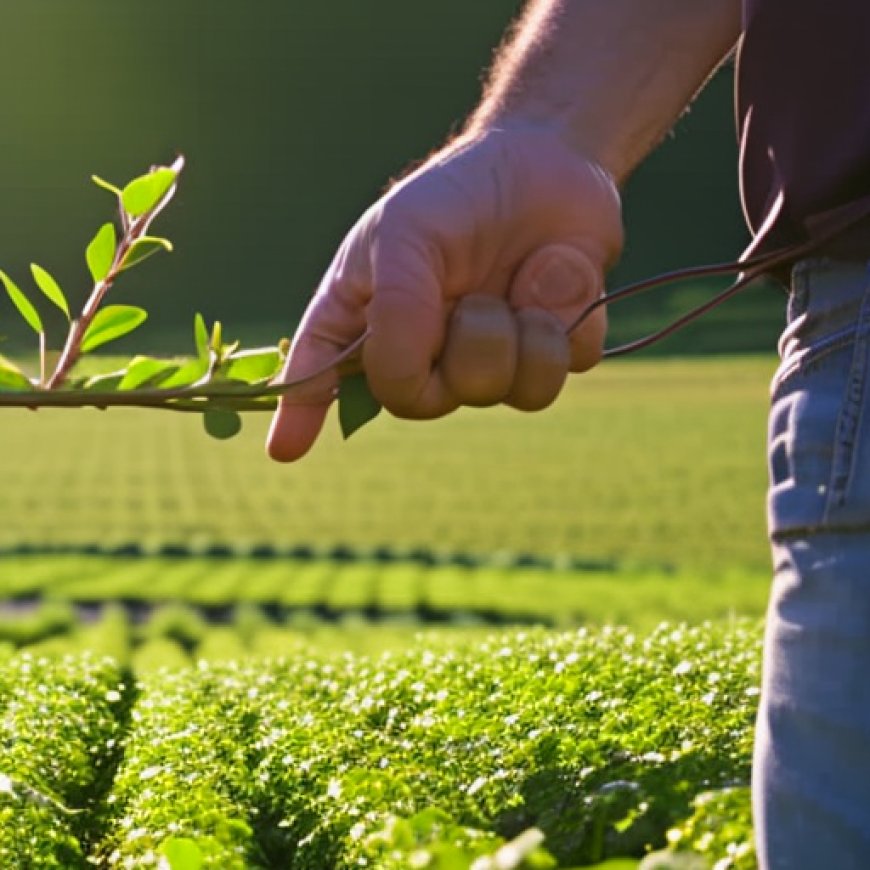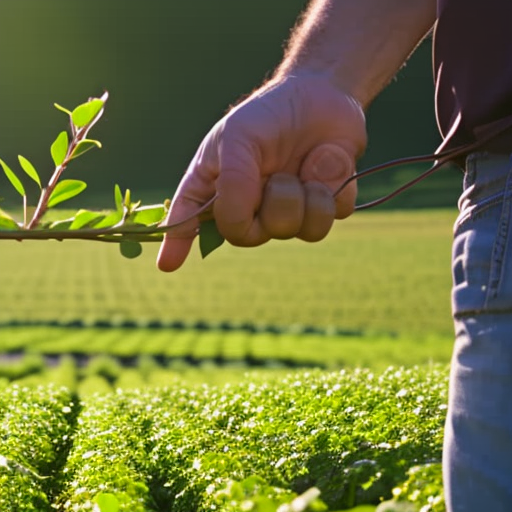SustainAg Network connects farmers with funding for producer-led conservation practices
SustainAg Network connects farmers with funding for conservation practices Farm Forum


Fields of bright green rye stand out among the mostly brown early spring fieldscape on Luke Hiebert’s crop and livestock farm northeast of Huron, South Dakota.
“Traditionally, at this point in the season, nothing would be growing out in those fields. This is the reason I decided to plant rye,” said Hiebert, during an early April conversation. “It has been growing since last fall, and I like having a living root in the soil as long as possible. It helps with compaction, reduces erosion, increases water infiltration, builds organic matter and overall, improves soil health.”
There are additional benefits to this sustainable practice. Because Hiebert is enrolled in the Covering America Program through AgSpire’s SustainAg Network, he will receive a premium for the rye seed when he harvests it late summer.
Program Benefits
- The program will cover the costs associated with the late season, multi-species cover crop he plans to plant on the same acres for his cattle and sheep to graze late fall.
- AgSpire connected him with one of their Technical Advisors to provide expert insights throughout the process.
“I and my wife, Briana are the third family trying to earn an income from this farm, so I need to look at value added opportunities because this farm is not large enough to support all of us,” explained the third-generation farmer who has been farming fulltime with his dad and uncle since he was 18.
For ag producers by ag producers
According to the recently released SustainAg Insights quarterly report, Hiebert is among 278 producers from across the U.S. who make up AgSpire’s newly formed SustainAg Network of farmers and ranchers interested in adopting sustainable land and livestock management practices through programs like Covering America. Since fully launching the Network in January 2024, AgSpire continues to expand its program offerings to farmers and ranchers, currently offering five programs, including a beef program in partnership with McDonald’s.
“AgSpire is focused on improving resiliency and sustainability across the entire agricultural supply chain,” explained Ryan Eichler, director of producer programs and a Lake Preston, South Dakota cattle producer. “Through The SustainAg Network, we connect producers with funding opportunities as well as resources to implement regenerative or sustainable practices.”
South Dakota crop and livestock producer Jared Knock came up with the idea for AgSpire after he observed a chronic disconnect between conservation-minded agriculture producers caring for land and livestock and funds allocated for regenerative agriculture practices by corporations and government entities.
“As a farmer who owns an ag retail business, I am closely connected to many farmers and ranchers trying to make changes on their land to increase soil health or livestock efficiency. At the same time, I was listening to what companies were saying about their desire to invest in farms and ranches in rural America for a positive environmental impact. But there was not a great way for the two groups to connect,” said Knock, who helped launch AgSpire in 2021.
“Our team has built an organization that connects sustainability-minded producers with those companies, developing and implementing programs around regenerative agricultural practices that benefit producers and improve our environment at the same time,” said Jared Knock, South Dakota Farmer & one of AgSpire’s founders.
Regenerative agricultural practices like planting late-season cover crops.
Hiebert said knowing that there is financial and technical help planting a late season cover crop motivated him to join The SustainAg Network and enroll in the Covering America Program.
“I had been thinking about planting a late season cover crop, but I knew it would be more difficult to get it going and I was not ready to invest in the risk,” Hiebert said. “With SustainAg Network, I have financial assistance, and because I don’t have a lot of experience planting cover crops, I appreciate the fact I also have access to a Technical Advisor.”
The SustainAg Network offers voluntary, incentive-based grant and private-market sustainability programs, like the Covering America Program, that are designed with producers like Hiebert in mind, explained Eichler.
“We keep the agriculture producer at the forefront of everything we do because quite frankly, without producers, none of this can happen,” Eichler explained. “We use a highly customizable approach because each farm and ranch is very different. The last thing that we want to do is dictate practices or environmental programs if they don’t fit the producer’s land or livestock efficiency goals.”
Eichler said The SustainAg Network’s team of advisors are essential to the process. “What sets us apart are our technical advisors,” Eichler said. “This team takes the time to
SDGs, Targets, and Indicators
-
SDGs Addressed or Connected to the Issues Highlighted in the Article
- SDG 2: Zero Hunger
- SDG 12: Responsible Consumption and Production
- SDG 13: Climate Action
- SDG 15: Life on Land
-
Specific Targets Under Those SDGs Based on the Article’s Content
- SDG 2.4: By 2030, ensure sustainable food production systems and implement resilient agricultural practices that increase productivity and production, that help maintain ecosystems, that strengthen capacity for adaptation to climate change, extreme weather, drought, flooding, and other disasters, and that progressively improve land and soil quality.
- SDG 12.4: By 2020, achieve the environmentally sound management of chemicals and all wastes throughout their life cycle, in accordance with agreed international frameworks, and significantly reduce their release to air, water, and soil in order to minimize their adverse impacts on human health and the environment.
- SDG 13.2: Integrate climate change measures into national policies, strategies, and planning.
- SDG 15.3: By 2030, combat desertification, restore degraded land and soil, including land affected by desertification, drought, and floods, and strive to achieve a land degradation-neutral world.
-
Indicators Mentioned or Implied in the Article
- Increased productivity and production in sustainable food production systems
- Improved land and soil quality through regenerative agricultural practices
- Environmentally sound management of chemicals and wastes
- Integration of climate change measures into agricultural policies and planning
- Combatting desertification and restoring degraded land and soil
SDGs, Targets, and Indicators Table
| SDGs | Targets | Indicators |
|---|---|---|
| SDG 2: Zero Hunger | 2.4: By 2030, ensure sustainable food production systems and implement resilient agricultural practices that increase productivity and production, that help maintain ecosystems, that strengthen capacity for adaptation to climate change, extreme weather, drought, flooding, and other disasters, and that progressively improve land and soil quality. | – Increased productivity and production in sustainable food production systems – Improved land and soil quality through regenerative agricultural practices |
| SDG 12: Responsible Consumption and Production | 12.4: By 2020, achieve the environmentally sound management of chemicals and all wastes throughout their life cycle, in accordance with agreed international frameworks, and significantly reduce their release to air, water, and soil in order to minimize their adverse impacts on human health and the environment. | – Environmentally sound management of chemicals and wastes |
| SDG 13: Climate Action | 13.2: Integrate climate change measures into national policies, strategies, and planning. | – Integration of climate change measures into agricultural policies and planning |
| SDG 15: Life on Land | 15.3: By 2030, combat desertification, restore degraded land and soil, including land affected by desertification, drought, and floods, and strive to achieve a land degradation-neutral world. | – Combatting desertification and restoring degraded land and soil |
Behold! This splendid article springs forth from the wellspring of knowledge, shaped by a wondrous proprietary AI technology that delved into a vast ocean of data, illuminating the path towards the Sustainable Development Goals. Remember that all rights are reserved by SDG Investors LLC, empowering us to champion progress together.
Source: farmforum.net

Join us, as fellow seekers of change, on a transformative journey at https://sdgtalks.ai/welcome, where you can become a member and actively contribute to shaping a brighter future.








